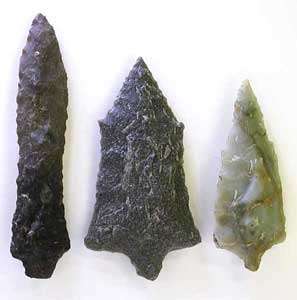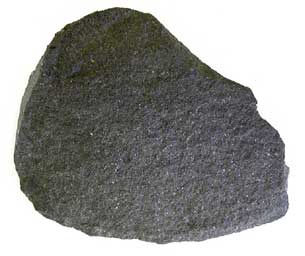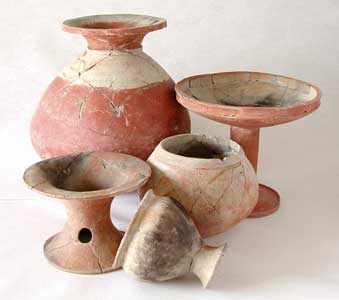Asahi:
The moat abandoned, the settlement transformed at the start of the 2nd century
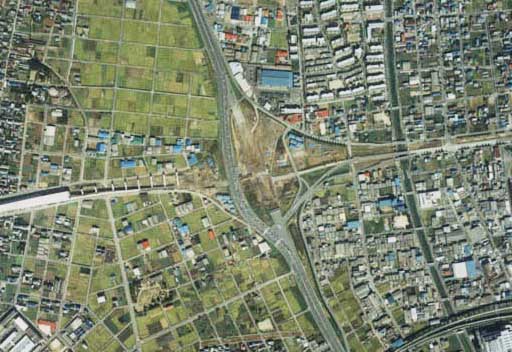
National Land Image(c)Ministry of Land, Infrastructure and Transport, Japan
(Above photo was shot in 1987)
 Locus of the
discovery of a whorl-shaped bronze shield ornament
Locus of the
discovery of a whorl-shaped bronze shield ornament
A whorl-shaped bronze shield ornament was recovered from the southern
settlement (near the pit-dwelling remains at the left edge of the
photo). Pit-dwelling remains, pits, layers of fill, etc. pile up in
complicated fashion, forming a culture-bearing layer of black-brown
silt 60 to 80 cm thick.
|
|
|
The Late Yayoi period settlement
The southern settlement shrank to one-third
its size as compared with the Middle Yayoi. Burials were made around
the settlement’s periphery. Various bronze objects were
recovered from within the settlement, suggesting it was a center of
bronze production.

Whorl-shaped bronze shield ornament
A whorl-shaped bronze ornament with five
arms twisting to the left, and a dome-shaped central boss. A
rod-shaped handle is housed within the boss. The state of
preservation is exceedingly good, and red iron oxide has been
detected on both the interior and exterior surfaces. Diameter 5.6 cm.
|
|
|
|
|
|

Bone and antler implements
Discovered in layers of shell in ditches, and in
natural water courses. From the left, a spatulate-shaped artifact of
deer antler, a puncturing instrument made from the metatarsal bone of
a deer, a conical bone point, a fixed harpoon head of deer antler, a
flat bone point with a pentagonal outline. The fixed harpoon head is
from the Late Yayoi, and the other items from the mid to latter
thirds of the Middle Yayoi periods.
|
|
|
|
|
|
Asahi Site, Kiyosu Town, Aichi Prefecture
Akatsuka Jirō, Kageyama SeiichiLocated in a low-lying portion of the Nobi Plain, the Asahi Site is a moated core settlement of the Yayoi period. Continuing from the Early Yayoi, the settlement changes at the start of the Middle Yayoi into a large moated settlement 800 m east-west by 300 m north-south (dimensions for the southern settlement). Further, a cluster of square moated burials, extending 400 m east-west, was formed. In addition, to the north a special settlement existed, somewhat small in scale but ringed by multiple moats. Taken together, the scale of these items can be inferred to extend over a wide area 1.4 km east-west, and 800 m north-south.
The moated village of the Late Yayoi period
In the Late Yayoi period, the northern settlement, ringed with multiple moats, and the southern settlement, though smaller in scale, continued to exist, but a cemetery precinct spread around the perimeter of southern settlement, with one portion of it forming beyond the moat. The southern settlement was rectangular in shape, approximately 300 m east-west by 180 m north-south, with an elliptical ditch dug within this area and provided with several entrances plus small projecting portions. Although details of the northern settlement are not clear because little progress has been made in its investigation, a scale of 230 m east-west and 200 m north-south is assumed.
The date of the last circular moat dug
In the most recent investigation, material enabling the determination of the final age for moat digging was obtained. Construction of the circular moat within the southern settlement dates to the first half of the Late Yayoi (the time of ceramic style Yamanaka I), with the Asahi site dissolving afterwards in rapid fashion, with no further digging of moats. A variety of bronze objects dating from that time have been recovered from the northern and southern settlements, and in the most recent investigation a whorl-shaped bronze shield ornament was found. Discoveries of bronze arrow points already number 40 items, indicating that conditions for the production of bronzes were favorable.
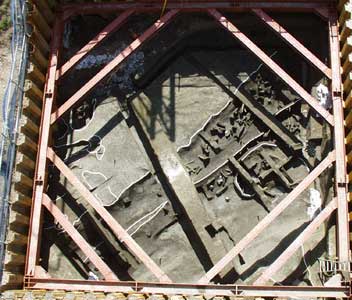
 Mound Tomb of late Yayoi, unearthed Yamanaka style pottery
Mound Tomb of late Yayoi, unearthed Yamanaka style pottery
